United States, New Mexico
Pueblo Nativities from New Mexico
Found in the Pueblo Indian Villages along the Rio Grande between Taos and Albuquerque in New Mexico, this unique Nativity culture is likely the only original contribution of the United States to the history of the Nativity.
The following Nativities are each displayed in a unique permanent setting created by Marian Library Crèche Collection volunteers. The descriptive text for each was written by Father Johann Roten, S.M.
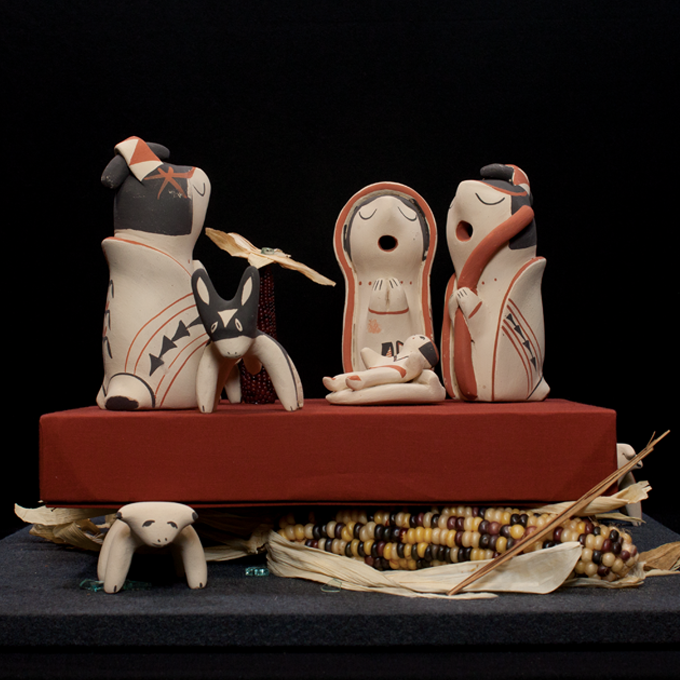
Corn and Rain
Mary Toya
Jemez Pueblo, New Mexico
These figures by Mary Toya of Jemez Pueblo are a modernized version of the traditional pueblo crèche figures. They are heavy with clay, rudimentary in execution for face and hands, but of exquisite coloring and ornamental design. The two principal ornaments used here are symbols of corn and rain, the lifeline of people threatened by drought and desert.
– ML.0069.17
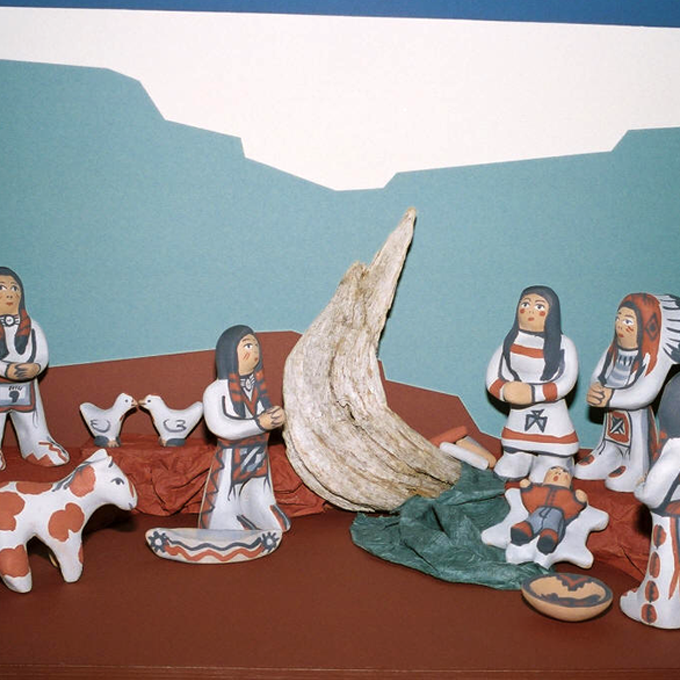
Making a Difference
Diana Wade
Isleta Pueblo, New Mexico
Influenced by both Jemez and Zuni traditions, Diana Wade, a resident of Isleta Pueblo, creates pieces with extensive hand-painted design. Each of the pieces of this set is made of natural clay. The scene is very Indian in style and ornamental design. The wise men are three chiefs, one in full headdress. The three gifts are a rattle, a canoe, and a drum. Only Baby Jesus makes a difference. He is in jeans and a western shirt, and is lying on a sheepskin rug.
– ML.0112.01
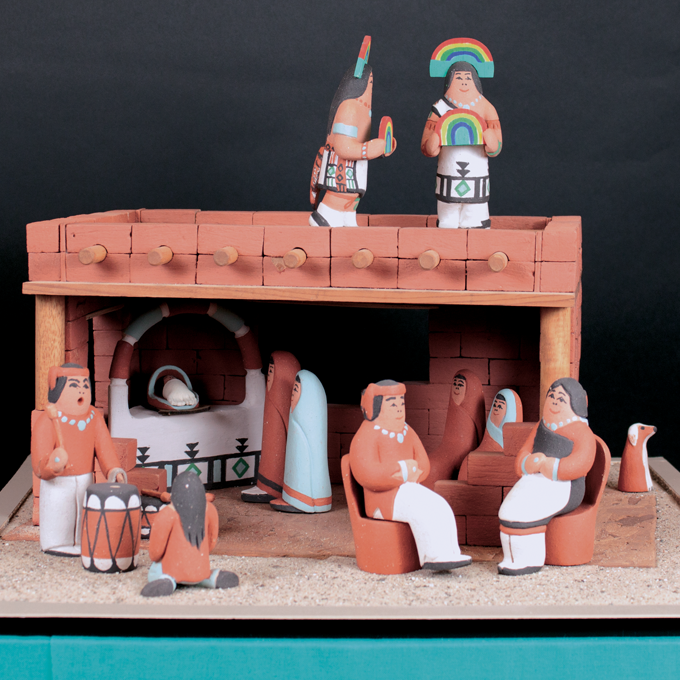
Adobe Nativity
Robert Toledo
Jemez Pueblo, New Mexico
The traditional house of Pueblo Indians is the adobe. The adobe is made of clay bricks which are sun-dried, sanded, painted, and fired—a process habitually used by the Pueblo potters to make crèche figures. This set by Jemez artist, Robert Toledo, points to the merging of two cultures: the traditional nativity figures are joined by two rainbow dancers.
– ML.1115.09
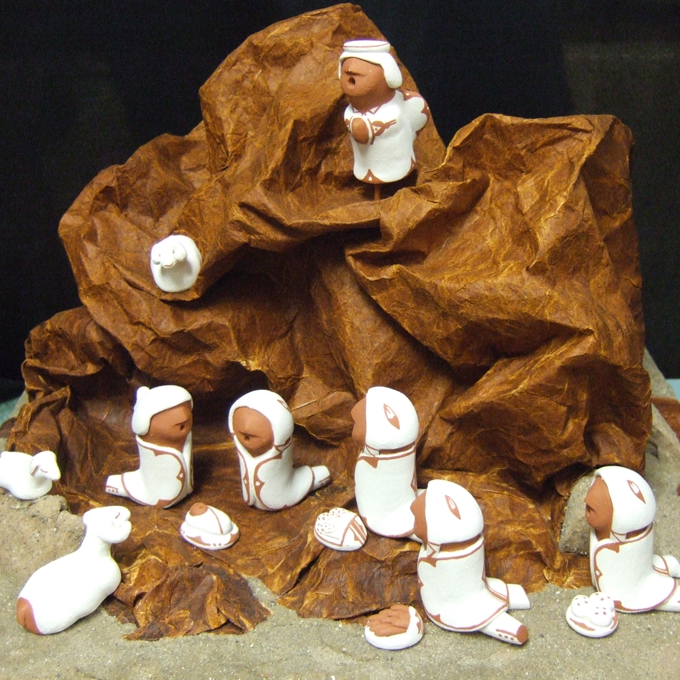
The Nose
Antoinette Concha
Taos and Jemez, New Mexico
Antoinette Concha from Taos and Jemez Pueblos, is the daughter of the well-known Alma Concha. Antoinette has a delicate touch. Her figures are identically clothed in elegant white colors. The faces are uniformly brown. The facial features are limited to a prominent nose. The nose is a typical element in many Indian nativities. It is the symbol of a living being. The nose is a sign that earth has come alive in a human being. Similarly, the sameness of color, faces, and dresses reflects our common origin from the earth.
– ML.1116.04
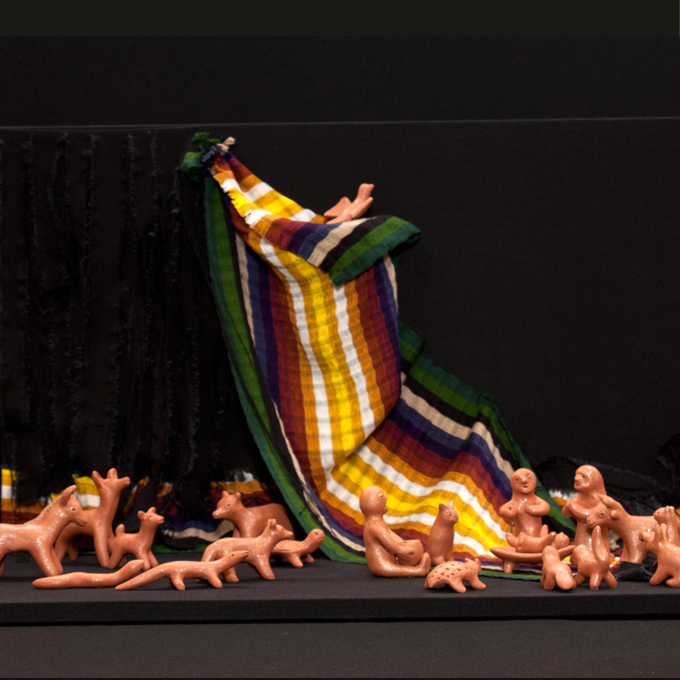
Faithful Companions
Ignacia Saya Duran
Tesuque Pueblo, New Mexico
Indian culture has a special liking for animals both for their mythological significance and faithful companionship. Animals, affectionately called animalitos, little animals, are frequently presented in nativities as shown in this set. Ignacia Saya Duran of Tesuque Pueblo works with micaceous clay, which gives to this scene, animated by tortoise, rabbit, snake, squirrel, lizard and bear, a scintillating quality.
– ML.1116.05
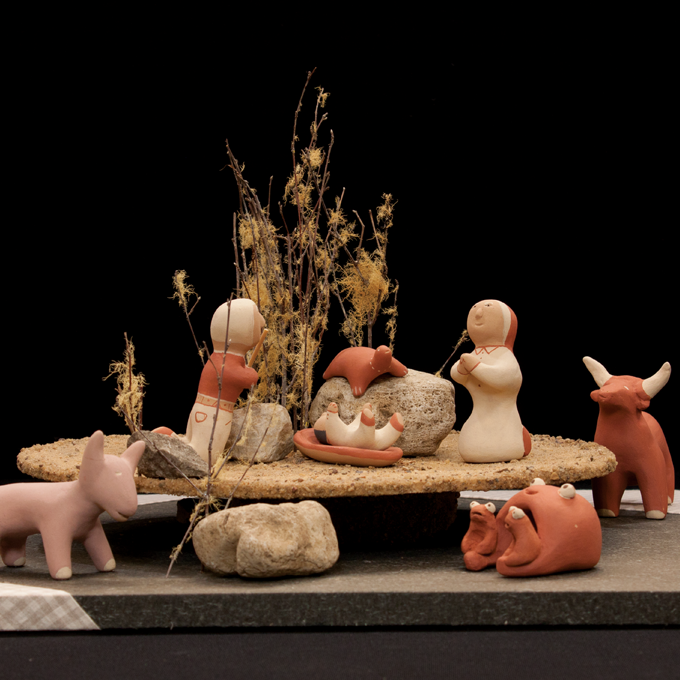
From the Frog’s Mouth
Reycita Garcia
San Juan Pueblo, New Mexico
Reycita Garcia of San Juan Pueblo relishes the soft hues of earthen colors, but her figures are “westernized.” St. Joseph is dressed cowboy style, the child wears Doctor Denton’s baby pajamas, and Mary proudly shows off the many buttons of her dress. However, the special feature of this set is the frog. He is a storyteller. Frogs are figures of wisdom and symbols of transformation. He tells the story of life from its simplest expression in water and mud to the coming of Jesus, the life-giver himself.
– ML.1116.06
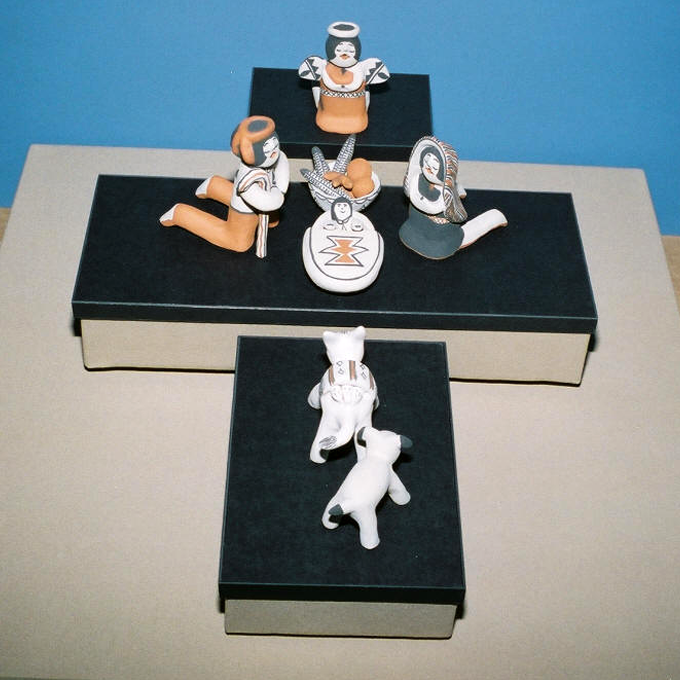
From the Earth
Martha Arquero
Cochiti Pueblo, New Mexico
Nativity figures in the Pueblo tradition do not have a personal message. They speak the language of clay and of the earth. This characteristic is made visible in this set through grey, black and brown tones. Martha Arquero accentuates closeness and familiarity with the earth by adding gifts of corn and fruit. The need to remember that we are from the earth is compensated with the sign of the butterfly on the baby’s cradle. The butterfly is a symbol of everlasting life.
– ML.1116.07
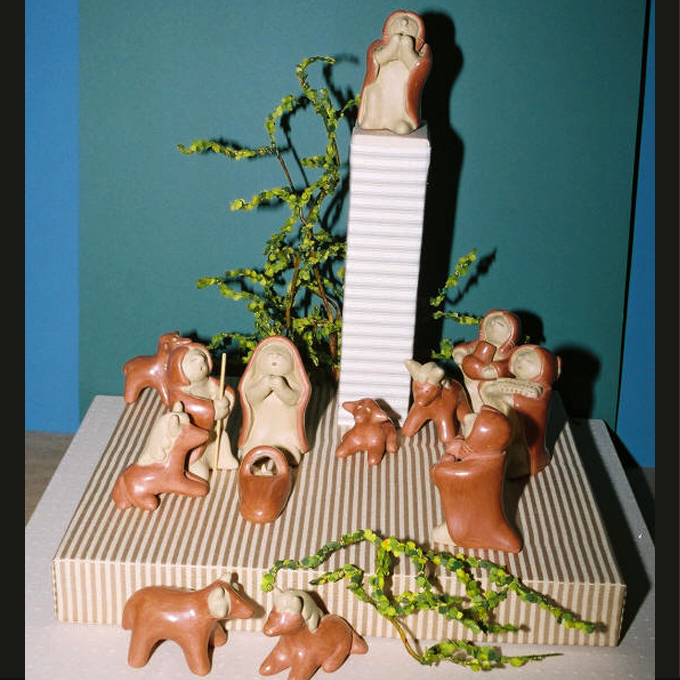
No Rest
Dorothy Gutierrez
Santa Clara Pueblo, New Mexico
Dorothy Gutierrez of Santa Clara Pueblo has been in the trade of making nativity sets for many years. She is noted for combining buff and polish. Most of her figures show tunics of unpolished light brown buff. Veils and mantels are richly contrasted with polished dark brown slip. The Infant Jesus is placed on a cradleboard, probably a reminder of Dorothy’s Najavo descent. The cradleboard is not a cradle that invites lullabies. It is typical of people frequently on the move. The cradleboard answers a practical need. It allows the mother to carry babies as comfortably as possible. Christian existence is frequently compared to a pilgrim’s journey. The comparison has its origins in Jesus Christ who had no place to rest his head.
– ML.1116.12
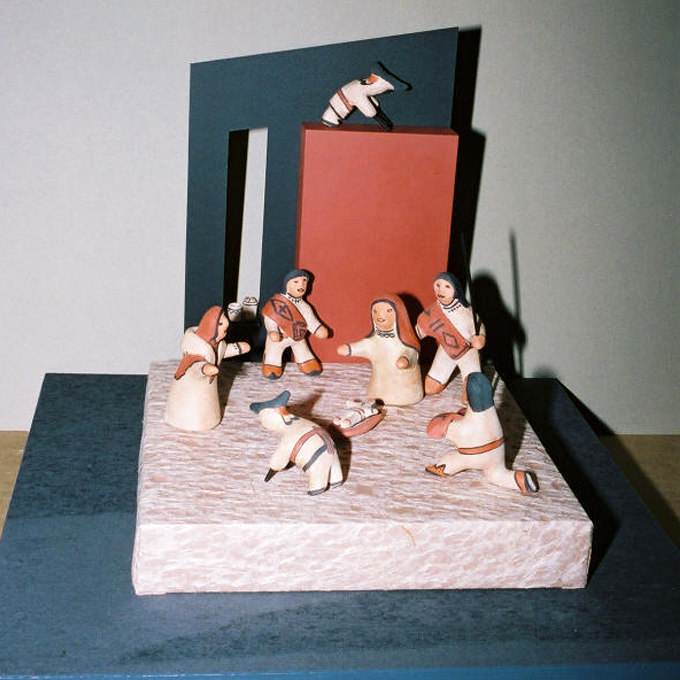
The Wedding Shawl
Alfred Aguilar
San Juan Pueblo, New Mexico
One of the great names among the Rio Grande Valley artists, Alfred Aguilar is a guardian of local tradition. His nativity sets are a marriage of Christian and pre-Christian customs. Among the typical gifts brought to the manger are pots and drums. Aguilar adds the traditional Indian wedding shawl. The wedding shawl brought as gift to the manger is a most appropriate symbol of unity and complementarity. The two stick dancers, representing deer and antelope, highlight honor and praise due to the Christchild.
– ML.1116.13
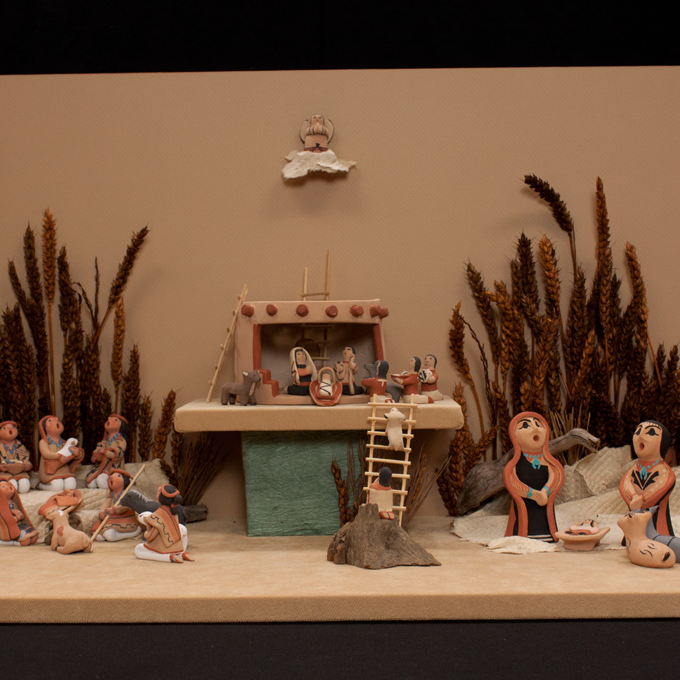
Christmas Enters the Kiva (3-part setting)
Mary Lucero, Santana Seonia, New Mexico
Edwina Tortalita, Jemez Pueblo, New Mexico
There are three sets in this setting. To the left is Mary Lucero’s sophisticated Pueblo nativity. The artist painted her little figures with an uncustomary abundance of details; even the turquoise necklaces are not forgotten. Structure and choice of color give this set a delicate beauty contrasting with Edwina Tortalita’s more statuesque and stately figures (right).
The central set is also from Jemez Pueblo. It features a Kiva, the house of prayer in the traditional Indian religion. Kivas are surrounded with mystery and great respect. A ladder leads into the Kiva. A second ladder stands out from the circular building and reaches into the sky. The vertical poles are of uneven length. They symbolize the two principal directions of human life: earth (the shorter pole) and sky (the longer pole) or material and spiritual values. Santana Seonia’s nativity suggests that Christmas has entered the Kiva, and thus points to a possible convergence between old and new religion.
– ML.1116.02
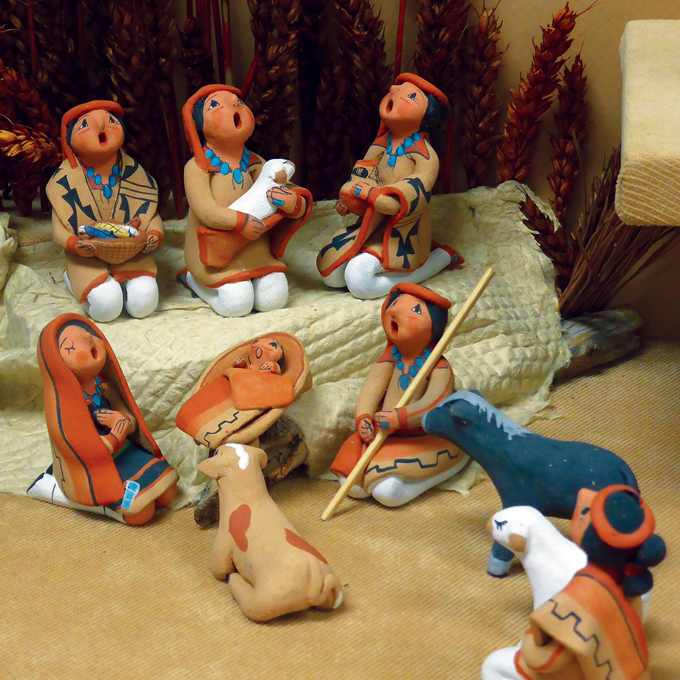
When displayed as a stand-alone piece, this nativity is titled "The Wonder of Telling"
Christmas Enters the Kiva Detail 1, The Wonder of Telling
Mary Lucero
Jemez Pueblo, New Mexico
This Christmas scene by Mary Lucero of Jemez is one of the most sophisticated of this collection of Pueblo nativities. The artist painted her little figures with an abundance of detail: eyes and hands are carefully drawn; even the turquoise necklaces are not forgotten. Structure and color give this set a feathery lightness. It almost looks like a choir of singing angels for all the little actors have the typically wide open mouth of Pueblo nativities. The open mouth is another symbol of people alive and well. They are telling a wondrous tale. Telling is important in Indian culture with its mainly oral tradition.
– ML.1116.14
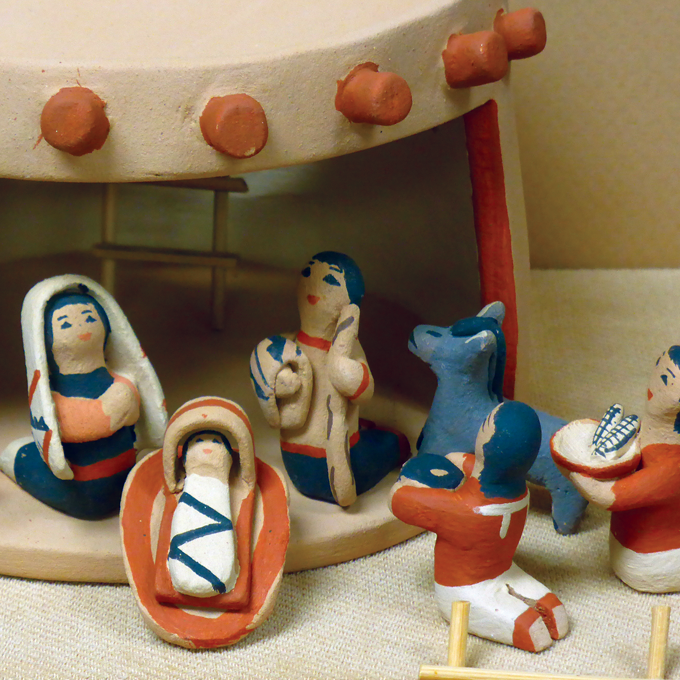
When displayed as a stand-alone piece, this nativity is titled "Ladder of Ascent"
Christmas Enters the Kiva Detail 2, "Ladder of Ascent"
Santana Seonia
Jemez Pueblo, New Mexico
Today, the spiritual center of the pueblo is frequently the typical Mission Church, if it is not replaced by the even older tradition of the Kiva, the house of prayer in the traditional Indian religion. Kivas, the building and the worship that takes place inside, are surrounded with mystery and great respect. Usually a ladder leads into the prayer house, and a second ladder stands out or up from the frequently circular building, reaching into the sky. The vertical poles are of uneven length and symbolize the two principal directions of human life: earth (the shorter pole) and sky (the longer pole), or material and spiritual values. The fact that Christmas has entered the Kiva points to a possible convergence between old and new religion. The nativity set was crafted by Santana Seonia from Jemez Pueblo.
– ML.1116.10
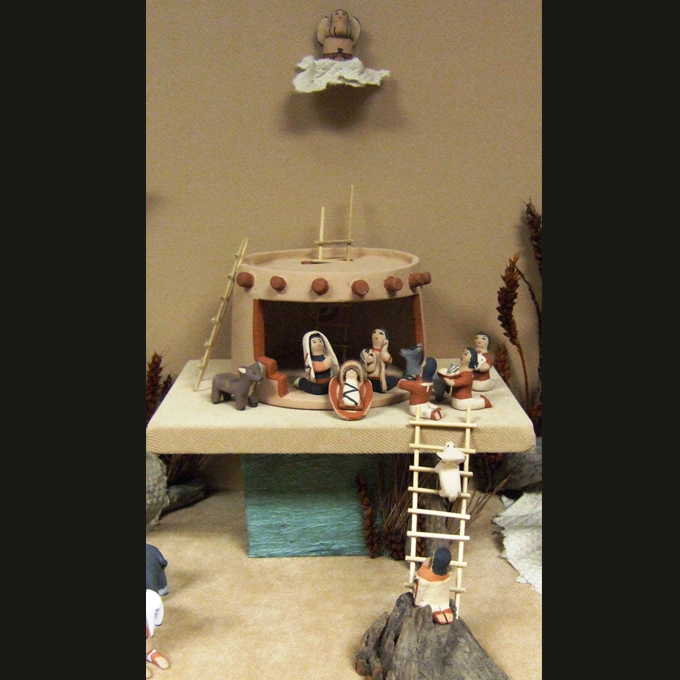
Wider view of "Ladder of Ascent"
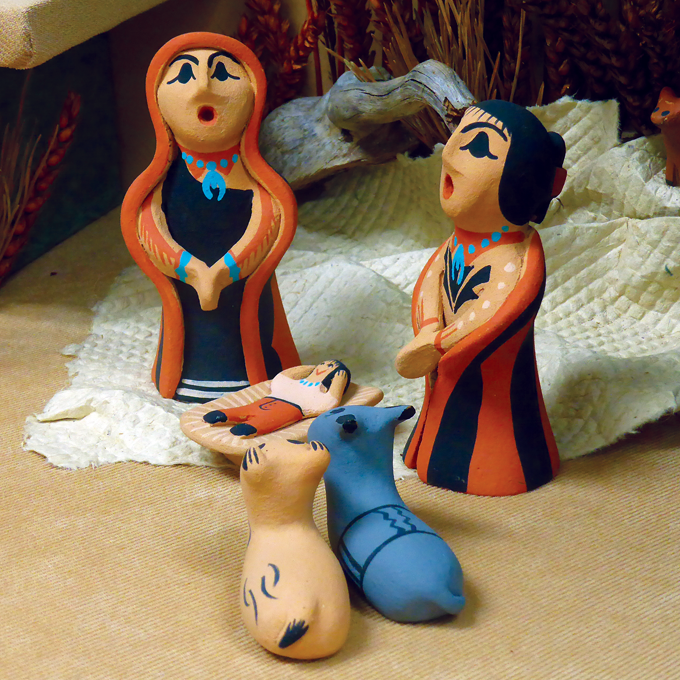
Christmas Enters the Kiva Detail 3
Edwina Tortalita
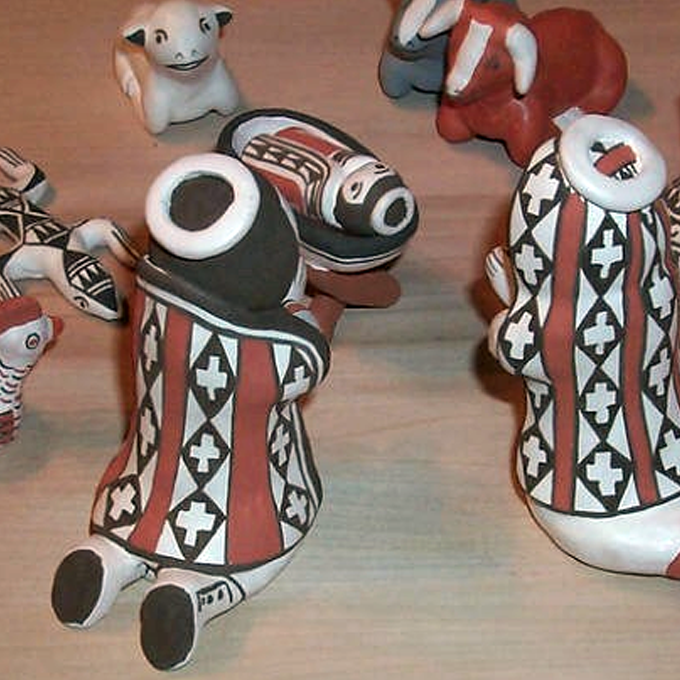
Paths Crossing
Ethel Shields
Acoma Pueblo, New Mexico
Ethel Shields is one of the grand old ladies of Pueblo nativities. Ethel's beautiful Acoma- style nativity reflects her preference for white, black and orange colors. The garments of Mary and Joseph are decorated with striking patterns. What seems to be like a field of crosses signals crossing paths in Indian symbolic language. Indian nativities are just that: traditional religion crossing paths with Christianity.
– ML.1116.11
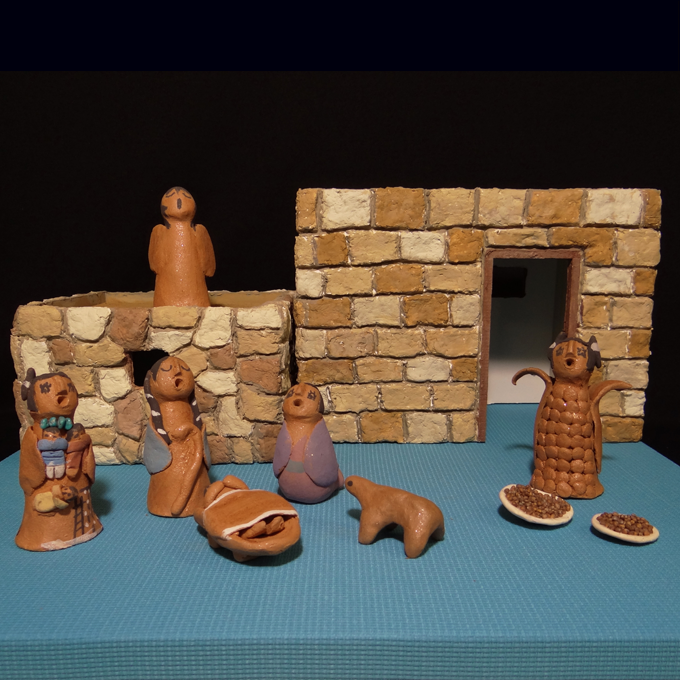
Three Mothers
Thelma Lujan
Taos Pueblo, New Mexico
Thelma Lujan of Taos Pueblo, who calls herself Rain Circle, has contributed a humble set where Indian tradition is represented with the corn mother and the better known storyteller. Together with Mary, they speak of the various roles of the mother: to give life (Mary), sustain it (corn mother), and to give it meaning and direction (storyteller).
– ML.1116.15
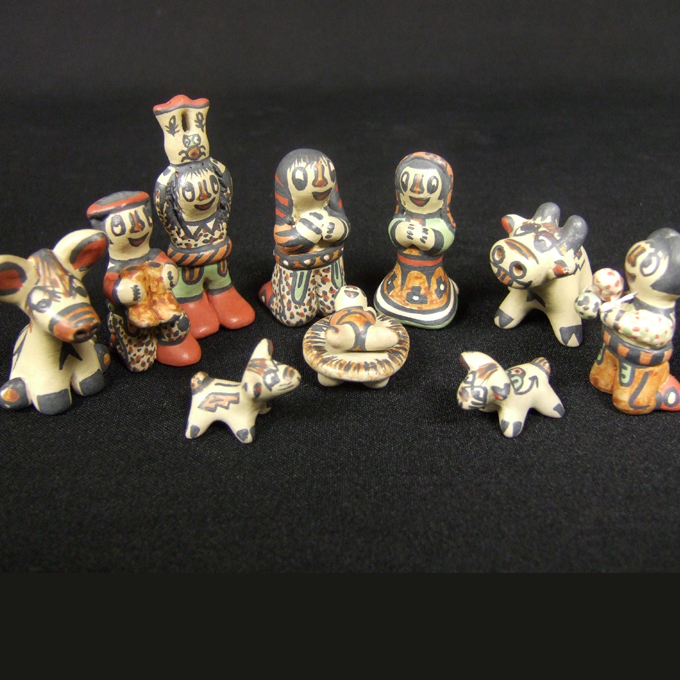
Indian Gifts
Margaret Gutierrez
Santa Clara Pueblo, New Mexico
The trademark of Margaret Gutierrez's art is the animated expression of human and animal figures, and the highly polished buff clay. Her favorite colors are red, black, green and gray, which she uses artfully and in intricate designs. A special feature of this set are the gifts presented by the wise men. These are typical Indian gifts: corn, moccasins, and a wedding vase. The wedding vase has two openings or double spouts for the newly wed couple to share and celebrate their union in difference.
– ML.1116.09
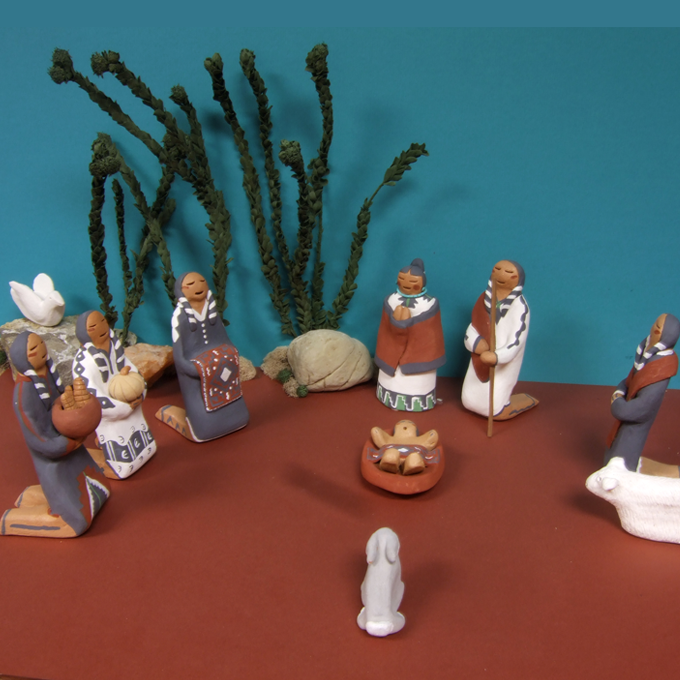
Honored Tradition
Juanita Dubray
Taos Pueblo, New Mexico
Juanita Dubray is from Taos Pueblo, and, like many of the Pueblo artisans, understands pottery-making as a call and vocation. She sees a great unity between her clay work and her life, family and environment. Before work, she centers herself spiritually "asking for power to be given to each new piece so that it will become a blessing to the person who owns it." The figures of this set have a noble countenance. They are peace-bringers as the white dove seems to confirm. Although painted in subdued colors, the discreetly scintillating effect of the micaceous clay speaks of inner joy and hidden grace.
– ML.1116.08
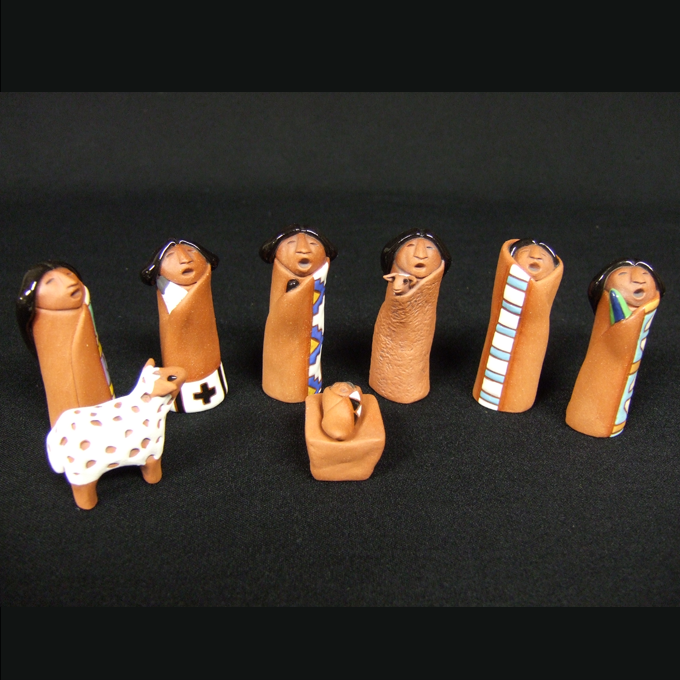
... And Beyond
Ann Graffy
Honored traditions have disciples. They are a source of inspiration especially for those who are seeking authenticity in the simple beauty of life's basic realities. This set is not by a pueblo artist but was inspired by Indian art. Its figures, tiny as they may be, reflect some of the characteristics of the Pueblo nativities. Beautifully plain in their wrap-around clothes they become a perfect showcase for the simple but highly effective ceramic ornamentation.
– ML.1116.03
